THE STORY OF SPARROW’S FARM, GREAT HENNY
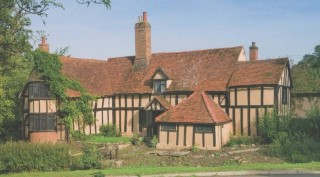
Sparrow’s Farmhouse from the west.
Early in 2011, my brother-in-law, Charles Horton, a farmer from Gloucestershire, came to view a small flock of Llanwenog sheep in Great Henny. He is a judge of this breed of sheep from West Wales and he came to certify the flock. The sheep were on the meadows at Sparrow’s Farm, which was then vacant following the death of its owner Daphne Machin-Goodall. Charles came back to us at Bures Mill saying that there was this romantic little farm, which was for sale and needed enthusiastic owners to care for it. Needless to say, Elizabeth and I went to look at Sparrow’s Farm and immediately fell for its charm. After many months of negotiations, we managed to buy it.
Sparrow’s Farm lies tucked away in the deep overgrown valley of the Loshes Brook, which is a tributary of the Stour. The farm adjoins the Loshes Meadow Nature Reserve and includes the original damp Loshes Meadow, where marsh, spotted and bee orchids grow. The farmhouse is situated at the junction of the parishes of Twinstead, Great Henny and Lamarsh and some of the farmland is in the parish of Alphamstone. The valley is steep enough to imagine you are in Devon rather than the border of Essex and Suffolk. The farmhouse is an ancient timber-framed Hall House, which dates probably from the 14th century. The blackened rafters in the roof show that it had an open fire in the centre of the house and the smoke found its way out of the gable ends of the roof.
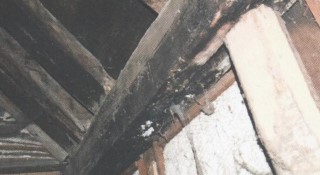
Wall plate and rafters with heavy soot blackening, showing that the building was built as an open hall.
With difficulty, we had squeezed into the roof to discover these blackened rafters. The house was altered in 1572, indicated by the date on the front of the dormer window. At that time, the chimney was inserted and the floor was put in to create a two storey building from the original lofty Hall House. It has not been possible to date it precisely with dendrochronology because the timbers are not large enough to include at least 30 annual rings. The oak was grown rapidly with wide annual rings. We are grateful to Brenda and Elphin Watkin for their historical study of the farm and its buildings. They have carefully traced the alterations to the farmhouse, the barn and the cottage over the centuries through examination of the timber structure and brick chimneys.
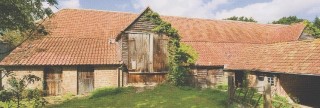
Sparrow’s Barn from the east.
Sparrow’s Farm has a large listed barn of ten bays, which stands opposite the farmhouse on the other side of the road. The barn is much bigger than would be needed for the present acreage of Sparrow’s Farm and indicates that, at an earlier date, it was part of a much larger farm. There are eight stables attached to the south side of the barn and the record of the Cook Family in the 19th century indicates that the farm had 16 carthorses to pull 8 ploughs and to cart the harvest. There is also an ancient cottage on the farm, which appears to have originally been a detached farm kitchen or service wing and bakery. It may have also been used for drying hops. There is a bread oven on the side of the cottage, where the bread for the farm was baked and, in our restoration, we have exposed the original entrance to the bread oven which was hidden at the rear of the fireplace. Before the 18th century there were a lot of hop gardens in the local area and the two large old riveted coppers in the cottage were possibly used for brewing beer. Unfortunately, the coppers were stolen when the farm was unoccupied, but we have been able to replace them. In the roof of the cottage, the date of 1747 is incised on the plasterwork with the initials EC, which indicates the possibility that an earlier Edmund Cook completed work on the building at that date. The tithe records show that Edmund Cook Jnr., born 1804 at Sparrow’s Farm, was the son of Edmund Cook Snr. and the grandson of the Edmund Cook whose initials are in the attic of the cottage.
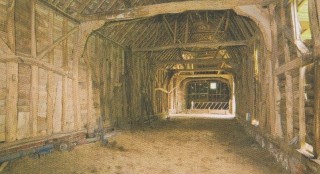
Interior of Sparrow’s Barn.
There is a remarkable record of farming at Sparrow’s Farm by Edmund Cook (1804-1887), who kept a meticulous farm diary and accounts for 50 years from Michaelmas 1837 to 1887 when he died. This unique record of 19th century farming is in the Essex Record Office and has been used as the basis of a PhD study on 19th century farming practice. Edmund Cook recorded details of the work taking place each day and the amount that he paid his men. His most skilled men received 10s6d a week and a boy received 2s6d. He was employing 21 men and boys in April/May 1838, including 3 horsemen. This shows what a large workforce was needed in the 19th century to manage a mediumsized farm. In the records, it shows that the men worked many days on hoeing the crops. Edmund Cook was an innovative farmer and he was reputed to have been the first man to use a threshing machine in the district. The barn contains two large midstreys with gault brick threshing floors where they would thresh and winnow the corn by using the draught through the barn to separate the grain from the chaff. There is record in Edmund Cook’s account book of threshing of wheat and barley in October 1837 and of threshing rye in February 1838.

Gault brick threshing floor in barn midstrey.
Edmund Cook married Alice Pung (from Grove Farm, Great Henny), thus bringing together Grove Farm and Sparrow’s Farm into a substantial farm of 428 acres, which perhaps accounts for the large barn at Sparrow’s Farm. We have some of the tithe records of Edmund Cook’s fields from the four parishes of Alphamstone, Great Henny, Lamarsh and Twinstead. These include the ancient field names which indicate the nature of the soil in each field. For example, a field to the south of the farm which is called ‘Leaden Croft’ is extremely heavy clay and, in the deep valley to the east, there is a field called ‘Swamper’, which is very marshy. On the old maps, to the north of the farm buildings, is an ancient orchard which is now overgrown with Blackthorn but still has some old pear trees in it, as well as one large apple tree, which we have not yet been able to identify.
Sparrow’s Farmhouse and the adjacent buildings have a number of colonies of honeybees living in the walls, which are reputed to have been there for a century. Some of the colonies are of immense size and it was necessary for us to remove two of them from the bedroom wall in the farmhouse, because they made a constant buzzing and heated up the walls with their activity, as well as, at times, coming up through the floorboards. Fortunately, we managed to transfer the bees, by use of a vacuum system, into new hives which are now located in the old orchard beyond the barn. We also removed over 60lbs of honey from the walls. We hope the bees will be happy in the newly restored orchard, once it is clear of the Blackthorn.
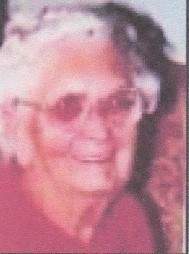
Daphne Machin-Goodall in her later years.
Sparrow’s Farm had remained in the same family for about 300 years until the death of the redoubtable Daphne Machin-Goodall at the age of 93 in 2008. She was a descendent of the Cook Family on her mother’s side and had been at the farm all her life. Daphne was renowned in the neighbourhood for her strong character, her sharp tongue and her expertise in horsemanship. She wrote several books on horses, including ‘A History of the British Native Pony’, ‘The Observer’s Book of Horses’ and ‘Horses of the World’. After the war, Daphne helped her sister, Vivien Boon, breed and train show jumpers, including ‘Neptune’, who won the Olympic Horse Trial with Vivien at Harewood in 1953 – the first such event won by a woman. Daphne also bred Suffolk Punch horses. There are many tales about her, including her going around the district in her horse and trap, with a long whip which she might use to emphasise her views, especially on people’s horsemanship. She had also bred Aberdeen Angus cattle and exported pedigree bulls to Argentina. She remains with us on the farm, as she is buried on top of Round Hill, at the highest point of the farm, with a view of Great Henny Church. At her funeral, her coffin was pulled to the top of the hill by a team of horses. The sheep like to sit on her grave and rub themselves on her gravestone!
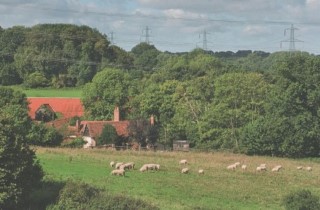
Sparrow’s Farm from the east.
As Sparrow’s Farm is heavily wooded and contains damp meadows and a variety of soils, and had not been farmed actively for many years in Daphne Machin-Goodall’s old age, it became overgrown with a richness of wildlife. Bat surveys have showed the presence of colonies of Daubenton’s bats, barbastelle bats and noctule bats (our largest native species), as well as the more common pipistrelle bats. In the summer months, we are visited by the hobby falcon, which is fast enough to hunt the noctule bats when they come out at dusk and is fast enough to hunt swifts and swallows on the wing. The hobby looks like a giant swift in flight. In June, we were visited by four hobbies who hunted the field voles which had been disturbed by the hay-cutting in the meadows. We have heard nightjars churring in the meadows on summer nights. The farm, as well as having areas of damp meadow with orchids, also has meadows with sandy acid grassland, with the characteristic species such as pearlwort and lady’s bedstraw. This dry, acid, lowland grassland is now rare in East Anglia.
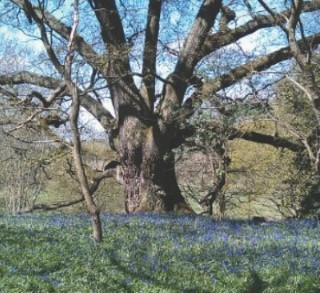
Ancient pollard oak and bluebells in Nub Hill wood at Sparrow’s.
On the north of the farm, there is an area of ancient woodland called Nub Hill, which contains great pollard oaks and is rich in bluebells and dog’s mercury, which are species indicative of ancient woodland. The overgrown wood and scrub land is an ideal habitat for nightingales and, in May, six males were singing within earshot of the farmhouse; the more experienced singers outdoing the younger males with the richness of their song. There are barn owls because of the thick, rough grassland and we are providing nesting boxes for them in the barns and in trees. The profusion of hazel in hedgerows and woodland has meant there is a population of dormice, which we hope to encourage by further planting of hazel in the hedges and the woods. It has been possible to enter Sparrow’s Farm into a Higher Level Stewardship Scheme, which gives support for the conservation of wildlife, alongside farming. We are in the process of a major fencing project to renew all the fences on the farm to accommodate our small herd of 20 Red Poll cows and our bull, Woldsman Admiral. He is of vigorous disposition and among his exploits is swimming the river at Bures Mill (our sister holding) and going through two fences in pursuit of one of our neighbour’s delectable cows which was in season. We could see where the term ‘bulldozing’ derived from. The new fences will contain our sheep, which include Black Hebrideans, Llanwenogs and Welsh Mountain Mules. The sheep have done a great job on the dense swathes of ragwort which covered the fields since they have a special taste for ragwort, despite its toxic nature.
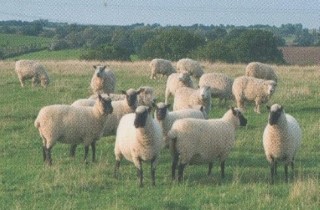
ALlanwenog sheep grazing on the ragwort at Sparrow’s Farm.
Sparrow’s Farm has had something of a problem with electricity pylons, since close to the northern boundary by the Loshes Brook, stands the giant Twinstead Tee pylon tower, where the 400,000 volt line from Bramford divides into two – one line going south towards Braintree and the other going off in a westerly direction towards Halstead. There is also a 132,000 volt line built from the old Cliff Quay power station at Ipswich, which goes in a westerly direction. As a result of the many wind turbines which have been built in the North Sea, close to the Suffolk coast on the Gabbard and Shipwash Sands, there is a need for a new 400,000 volt line to come through from Bramford, which would follow the route of the original 132,000 volt line. Fortunately, as a result of the great efforts of Colne Stour Association and the Stour Underground, the new 400,000 volt line will run underground across the Stour Valley to the south of Sparrow’s Farm, which will lose all the overground lines and towers that cross the fields.
Dek and Jo McKinnon are living at Sparrow’s Farmhouse and are running the farm together with the land at Bures Mill, which is also mostly pasture and old water meadows. We are together gradually restoring the farm, replacing all the fences and gates, replanting hedgerows and woodland, repairing the farm buildings and building yards to accommodate the cattle during the winter. We are producing Red Poll beef and lamb on the farm meadows and hope to sell all our produce locally. We hope that we can have a productive farm alongside preserving and encouraging the wildlife, which abounds at Sparrow’s.
Nicholas Temple
Nick wrote an interesting history of Bures Mill for the 2011 Magazine. He thinks there is so much more to be discovered about Sparrow Farm that I have asked if he will do a follow up for 2015.
